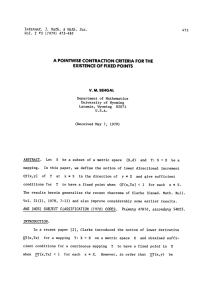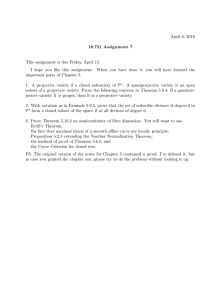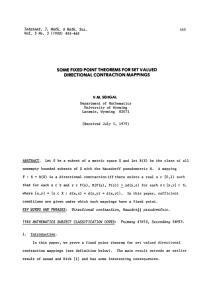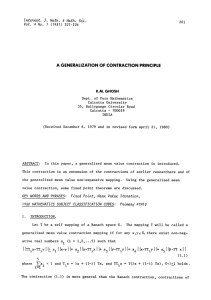A FIXED CONTRACTION POINT THEOREM FOR
advertisement
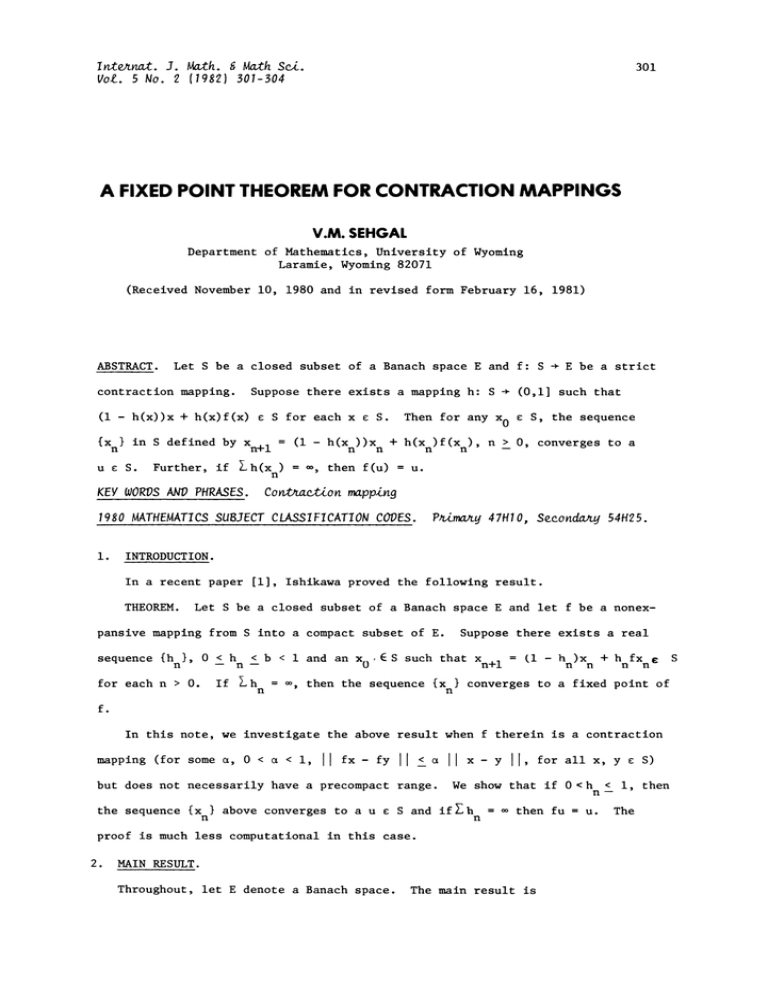
I ntrn. J. Mh. & Math Sci.
Vol. 5 No. 2 (1982) 301-304
301
A FIXED POINT THEOREM FOR CONTRACTION MAPPINGS
V.M. SEHGAL
Department of Mathematics, University of Wyoming
Laramie, Wyoming 82071
(Received November i0, 1980 and in revised form February 16, 1981)
ABSTRACT.
Let S be a closed subset of a Banach space E and f: S + E be a strict
h(x))x + h(x)f(x) e S for each x e S.
(I
{x
n
in S defined by
u e S.
Xn+ 1
l h(xn)
Further, if
h(x ))x +
(i
n
-,
n
Then for any x
h(xn)f(Xn)
then f(u)
0
e S, the sequence
n > 0
converges to a
u.
Conraton mapping
KEF WORDS AND PHRASES.
1980 MATHEMATICS SUBJECT CLASSIFICATION CODES.
i.
(0,1] such that
Suppose there exists a mapping h: S
contraction mapping.
Primay 47H10, Secondary 54H25.
INTRODUCTION.
In a recent paper [i], Ishikawa proved the following result.
THEOREM.
Let S be a closed subset of a Banach space E and let f be a nonex-
pansive mapping from S into a compact subset of E.
sequence {h }, 0 < h
n
n
for each n > O.
If
< b < i and an
.hn
=, then
Xo, S
Suppose there exists a real
such that
Xn+1
(i
+/-
the sequence {x
n
h )x
n n
+
h fx
n n
converges to a fixed point of
f.
In this note, we investigate the above result when f therein is a contraction
mapping (for some
,
0 < e < i,
II
fx- fy
II
<_
e
but does not necessarily have a precompact range.
the sequence {x
n
above converges to a u e S and
II
x- y
II,
We show that if 0 < h < I, then
n--
ifhn
then fu
proof is much less computational in this case.
2.
MAIN RESULT.
Throughout, let E denote a Banach space.
for all x, y e S)
The main result is
u.
The
S
302
V.M. SEHGAL
THEOREM i.
E be a contraction map-
Let S be a closed subset of E and f: S
(0,I] such that for
there exists a mapping h: S
ping satisfying the condition:
each x e S,
h(x))x + h(x)f(x)
(I
If x
e S and the sequence {x
0
in S is defined by
n
h(Xn))Xn + h(xn)f(Xn)
(i
Xn+ I
{Xn
then (a) the sequence
(i.l)
S.
(1.2)
n > 0,
h(xn)
converges to a u e S and (b) if
=,
then u in
(a) is the unique fixed point of f.
The following result (see Knopp [2], Theorem 4, p. 220) is used in the proof
of Theorem i.
Let {a
PROPOSITION i.
be a sequence of reals with 0 < a
n
n
(i
a )}
i
i=l
Proof of Theorem i.
b > 0 if f
sequence
n
n
x
n
Xn)
(i.3)
x ).
n
h )(fx
n
n
(i
n+l
Then the
It follows by (2) that
h (fx
n
n
x
and fx
.
<
h(Xn).
Let h
Xn+ I
an
< i.
n
(i.4)
Thus, for each positive integer n,
II fXn -Xn II
II fXn -fXn_l II + II fXn_ I -Xnll
all xn -xn-I II + (i- hn i II fxn-i
<
<
Xn-i II
Therefore, it follows by (1.3) that
<_
(hn_ I
Thus
{If
+
hn_l) fXn_ I
i
x
fx
n
II}
n
Xn_ I
II
)hn_l)l fXn_ I
(I
(i
II’
Xn_ I
is a decreasing sequence of non-negative reals.
Further-
more, it follows by successive iterations on the last inequality that for any
n> 0,
II
fx
Set
Uo
x
n
n
II
n-i
)hi)Ilfx0
(I
(I
<
i= 0
x
0
II
II
<
fx
0
x
0
II.
(i.5)
n
1
(i
)h..
i
Uo)}
H (i
Since 0 < Uo < i,
i
is a decreasing sequence
1
i’0
n
(i
of positive reals and hence there is a b > 0 such that
i=0
sider two cases (i) b > 0 and (ii) b
(i
e)h. <
1
and hence
II Xn+I
[_h.1
x
n
<
II
=.
<
0.
u
i)
fx
0
We con-
If b > 0, then by Proposition i,
Consequently, by (1.3) and (1.5),
II
b.
x
0
II
hn
<
.
FIXED POINT THEOREM FOR CONTRACTION MAPPINGS
This implies that the sequence {x
a u e S such that {x
(1.5)
lows by
is a Cauchy sequence in S and hence there is
Thus (a) holds in this case.
u.
n
n
303
0 then is fol-
If b
that
II
x
If
fx
n
n
0.
(1.6)
Since for any m > n,
m
n
m
m
m
it follows that
{x
II
x
m
x
n
II
n
n
m
<_
)-i II
x
fx
n
n
lows by (1.6) that u
-(1
c)h
fu.
and hence by Proposition 1
n
by case lii) the sequence {x
u and fu
n
b
u.
0 as n-
-iIIo
(1
.
Thus
Furthermore, it fol-
Now, if h(xn
(a).
This establishes
II
S.
is a Cauchy sequence and hence converges to a u
n
n
n
n
2(1-
n
u
0
i
then
Consequently
The uniqueness is obvious for
such mappings.
{z e E: z
For x, y e E, let ix,y]
[x,y] \ ix,y}.
(x,y)
Let
As an application of Theorem i, we have
Let S be a closed subset of E and f: S
COROLLARY i.
mapping.
h)x + hy, 0 < h < i}.
(i
E be a contraction
If for each x s S, there exists a y e [x,fx] r, S such that fy e S, then
f has a fixed point.
PROOF.
(0,i] as follows.
Define h: S
Clearly, y # x and y
(I
h)x + hfx for some h with 0 < h < i.
in this case. Thus (I.i) holds.
any x
0
e S and the sequence {x
(i
Xn+1
Note that if f(x)
n
S.
S then h(y)
Let h(x)
i.
h
Now, for
defined by (1.2) that is
h(Xn))Xn + h(Xn )f(xn)’
e S or fx
n
n
i and if
S (such a y exists by hypothesis).
S, then choose a y [x, fx] n S with fy
fx
fx
If fx e S, let h(x)
In either case
either
h(Xn
h(xn
.
1 or
h(Xn+ I)
1 according as
Thus by Theorem i, f has a fixed
pcint.
It is known (see [3]) that if S is a closed subset of E and x, y e E such that
x is an interior point of S and y
S, then there z e (x,y) n S.
As a consequence
of this result and Corollary i, we have
COROLLARY 2.
ping.
Let S be a closed subset of E and f: S
E be a contraction map-
If f(S) c_ S then f has a fixed point.
PROOF.
If for x e S, fx e S, then y
x satisfies the condition in Corollary
304
V.M. SEHGAL
i and if fx
S then by hypothesis x
with fy e S.
Thus by Corollary i, f has a fixed point.
We now give two examples.
Example i shows that Corollary 2 is indeed a special
-n
0, 2
Let S
3-2
f (0)
It is clear that any x, y e S,
be defined by h(0)
-n,
(i.i) holds.
h (xn)
<
in Theorem
I, then
II
-(n+3)
n > 0,
II
fx- fy
II
(318)
<
(4/5) for x
-(n+l)
2
I and h(x)
Further, if x 0
R (reals) by
Define a mapping f: S
0.
h(x))x + h(x)f(x)
(I
S0}.
n
f(2 -n)
x-- 2
S
may not converge to a fixed point.
n
EXAMPLE i
Consequently there is a y e (x,fx)
In Example 2, we show that if
case of Theorem i.
the sequence {x
S.
O.
x- y
then by (1.2)
(0,I]
Let h: S
It is easy to verify that for
while for x
i
II.
2
x
n
Theorem i implies the existence of a u e S with fu
0, it is clearly 0.
-n
and since
Thus
.h(xn
u (which is 0 in this case).
Note that f(S) is not a subset of S.
EXAMPLE 2.
n
a
=i2
n
{a
2
(I
b > 0.
n
{an
Let
-i
be a sequence of reals defined by a
for n > 2
2
-i
-i
[O,b] u {an
h(x)
_>
i,
an+I
x-n)
<
(0,i] by
[0,b]
if x
a
n
n > i.
-h(an))an + h(an )f(an).
(i
follows that f satisfies (lol)
structed in (1.2), then x
n
n > i}.
i if x e
2-n,
_)h(Xn?
it follows by Proposition i that
<
Define h: S
"x for each x e S.
Then for any n
I and
Let
S
Let fx
Since
I
a
/l.so, if x0
n
and {x
n
Since
f[0,b] _c [0,b],
l, and the sequence
b but f(b)
b.
{Xn
it
is as con-
Note that
in this case.
REFERENCES
i.
ISHIKAWA, SHIRO.
2.
KNOPP, KONRAD.
3.
SU, C. H. and SEHGAL, V.M.
Fixed Points and Iteration of a Nonexpansive Mapping in a
Banach Space, Proc. Amer. Math. Soc. 59 No. 1(1976), pp. 65-71.
Theory and Applications of Infinite Series, Second English
edition, Hafner Company, New York.
Some Fixed Point Theorems for Nonexpansive
Mappings in Locally Convex Spaces, Boll. U.M.I., (4) 10(1974), pp. 598-
601.



